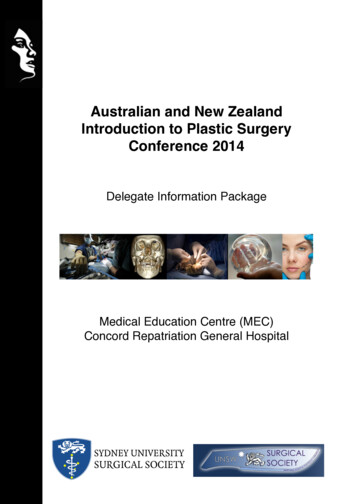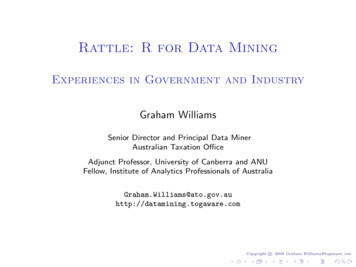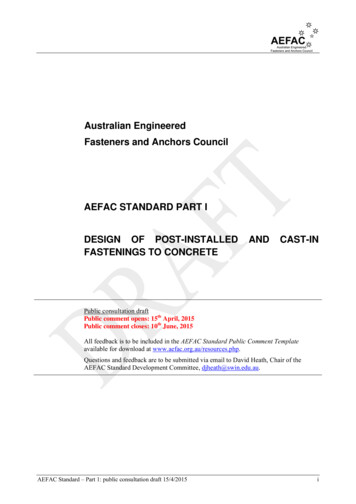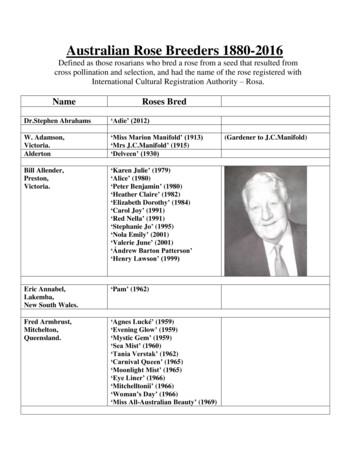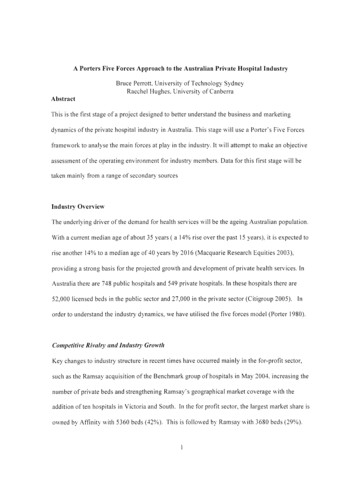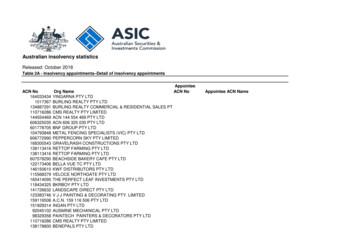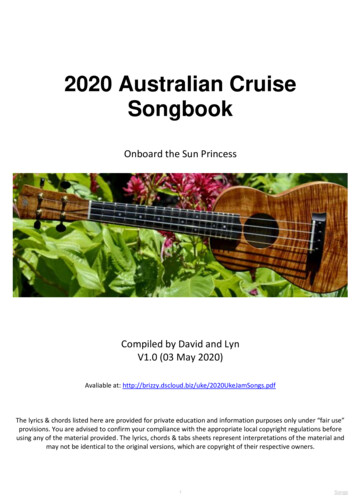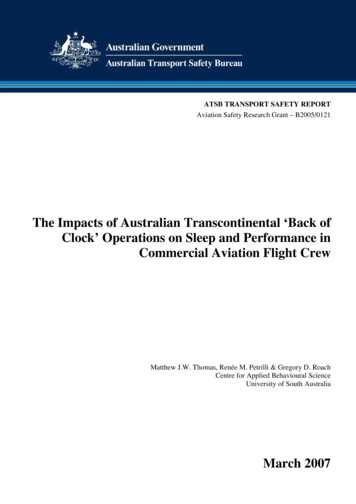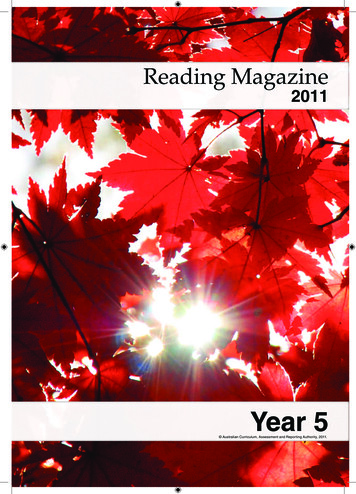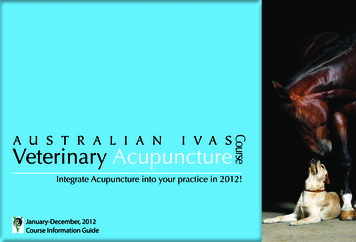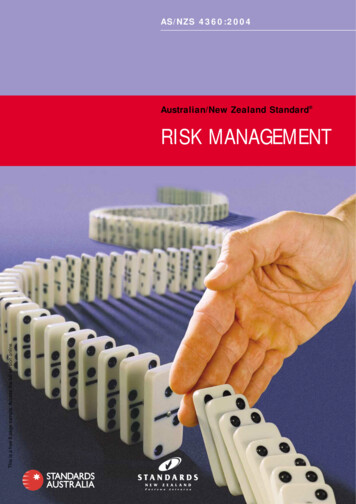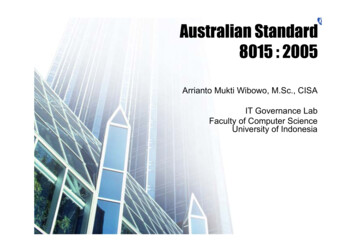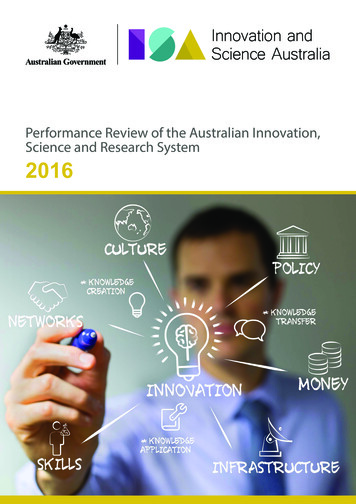
Transcription
Innovation andScience AustraliaPerformance Review of the Australian Innovation,Science and Research System2016
Innovation andScience AustraliaPerformance review of the Australian Innovation,Science and Research System2016
Commonwealth of Australia 2016ISBN: 978-1-925092-88-2 (print)ISBN: 978-1-925092-89-9 (online)Performance Review of the Australian Innovation, Science and Research System 2016With the exception of the Commonwealth Coat of Arms, this work is licensed under a Creative CommonsAttribution 4.0 International licence (CC BY d.enThird-party copyrightWherever a third party holds copyright in this material, the copyright remains with that party.Their permission may be required to use the material. Please contact them directly.AttributionInnovation and Science Australia (2016) Performance Review of the Australian Innovation,Science and Research System 2016. Commonwealth of Australia. Canberra.Use of the Coat of ArmsThe terms under which the Coat of Arms can be used are detailed on the following website:http://www.itsanhonour.gov.au/coat-arms
iForewordForewordSince the dawn of civilisation, innovation has driven human progress. What many take for granted—the elimination of diseases such as polio and smallpox, breakthrough antibiotic treatments such aspenicillin, safe and efficient travel courtesy of the jet engine, individual access to computing andcommunications power within a hand-held device—all of these benefits have been delivered byinnovation. Innovation is an essential driver of productivity and economic growth; hence governmentsaround the world are grappling with how best to encourage and support more of it.In recognition of the importance of innovation to our future prosperity, in December 2015, theAustralian Government announced its National Innovation and Science Agenda (NISA). One of theinitiatives in the NISA was the formation of Innovation and Science Australia (ISA), an independentstatutory body with the remit to provide whole-of-government advice on all science, research andinnovation matters. A key deliverable for ISA is to develop a strategic plan for improving and enhancingAustralia’s Innovation, Science and Research System that extends to 2030. Our intention is to deliver aplan to government by late 2017.The ISA Board is also tasked with the oversight of a number of Australian Government innovationsupport programmes, including the Research and Development Tax Incentive, the Venture CapitalLimited Partnerships and Early Stage Venture Capital Limited Partnerships funding, the Entrepreneurs’Programme elements, the Biomedical Translation Fund, and the Cooperative Research Centres.ISA’s board is composed of a mix of members drawn from industry and science with extensiveexperience in innovation and entrepreneurship (Appendix A). The board’s areas of expertise includeventure capital funding, start-ups and early-stage innovative businesses, academic research, innovationwithin large businesses and translating research into commercial opportunities. I am assisted in my roleas Chair of this committed group by Dr Alan Finkel, Australia’s Chief Scientist, as the board’s deputychair.ISA’s mission is the realisation of an ambitious vision for Australia’s future, one in which science andinnovation play a central role in securing our prosperity and addressing the great challenges of ourtimes. Australia must be ambitious in facing these challenges. We are a country with incredibly talentedand industrious people and we must aim to optimise our innovation potential. This means creating,transferring and applying knowledge to achieve a sustainable high-growth economy and protect theenvironment and social fabric of this great nation.This is an important and exciting challenge. As a nation we currently spend more than 33 billionper annum on research and development and it is essential we optimise the benefits from suchinvestments.ISA’s important work begins with this Performance Review of the Australian Innovation, Science andResearch System (ISR System Review). The ISR System Review does not make specific recommendationsfor future government decisions, but instead provides a baseline from which to develop the 2030Strategic Plan and measure future progress. Nonetheless, the findings in the ISR System Reviewmake one thing very clear: we need to significantly lift our game if we want to be a top tierinnovation nation. My fellow board members and I hope that the ISR System Review will providevaluable insights and guidance to stakeholders during this critical evaluative period of the process. Welook forward to seeking input through broad consultation for our task ahead.The production of this ISR System Review would not have been possible without contributions from awide range of stakeholders and experts from across government, business, academia and the public. Iwould particularly like to acknowledge and thank PricewaterhouseCoopers for its pro bono assistance indeveloping the performance scorecard, and the Australian Council of Learned Academies for conductingworkshops and sharing valuable insights gained through the Securing Australia’s Future workprogramme. I would also like to thank those staff members from the Department of Industry, Innovationand Science, including the Office of the Chief Economist, the Department of the Prime Minister andCabinet’s Project Office, and many other stakeholders who contributed throughout the drafting process.Bill Ferris ACChair, ISA BoardDecember 2016
Innovation andScience AustraliaiiPerformance Review of the AustralianInnovation, Science and Research System 2016ContentsForeword iExecutive summary viIntroduction 1Overview 2What is innovation? 3What is research? 3What is science? 3Why innovate? 3National and global context 6Part A: Measuring performance What is the Innovation, Science and Research System? Framework for assessment Part B: Performance assessment 9101115Enablers 16Policy 16Money 34Infrastructure 54Skills 62Networks 81Culture 88Outputs 96What are Australia’s innovation outputs? 97Who produces Australia’s innovation outputs? 99Strengths 101Weaknesses 103Findings: Outputs 103Outcomes 104Economic outcomes 104Social outcomes 107Environmental outcomes 108Strengths 109Weaknesses 109Findings: Outcomes 110
iiiContentsPart C: Overall findings and next steps 111Performance of the Australian Innovation, Science and Research System 112Knowledge creation 113Knowledge transfer 113Knowledge application 114System-wide 115Outputs 115Outcomes 116Key findings 118Scorecard 120Prioritisation and selection of the scorecard indicators 120The performance scorecard 121The 2030 Strategic Plan 123Part D: Appendices 125A ISA Board Member biographies 126B Acronyms and glossary 131Acronyms 131Glossary 133C Consultations Stakeholders list 138138D Scorecard performance metrics 142Knowledge creation 142Knowledge transfer 145Knowledge application 146Outputs 148Outcomes 148E Summary of Australian Government programmes 149F Summary of Australian Government programme assessments 152G State and territory programmes 155H Areas for regulatory improvement 156I160Networks of different types in Australia J Initiatives related to innovation in Indigenous communities 163Notes 165
ivInnovation andScience AustraliaPerformance Review of the AustralianInnovation, Science and Research System 2016
EXECUTIVE SUMMARY
viInnovation andScience AustraliaPerformance Review of the AustralianInnovation, Science and Research System 2016Executive summaryWhilst Australia enjoys an enviable level of broad-based prosperity, we must invest wiselyin order to sustain it. The forces of technological change are increasingly disrupting oureconomy but at the same time opening new and compelling paths to future wealth. As anation we must harness these changes to our shared advantage.The context for the Innovation, Scienceand Research System ReviewAustralia has maintained a sustained period of economic growth and high employmentfor the past 25 years, including through the Global Financial Crisis when many otherdeveloped nations fell into recession. For Australians, this growth has increased GDP percapita, delivered jobs and higher standards of living. On average, we enjoy some of thelongest lives, best-quality services and most liveable communities in the world.Australia, like many countries, has seen a recent slump in productivity growth. Ifproductivity growth is not revitalised, Australia risks a prolonged period of stagnation.At the same time, the accelerating pace of technological change is causing structuralshifts in key industry sectors and employment patterns. Long-term trends, such as theageing of the population and changes in the climate, present complex challenges thatcommunities will have to solve together.Against this backdrop, the Australian Government recognised through the NationalInnovation and Science Agenda (NISA) that a robust, resilient, and efficiently functioningInnovation, Science and Research System (the ISR System) is critical to the opportunitiesall Australians will enjoy. The government has therefore asked Innovation and ScienceAustralia (ISA), an independent statutory board, to review the current performance of theISR System (the ISR System Review). This assessment will inform a long-term strategicplan for the development of the ISR System to 2030.In the ISR System review, we consider a range of performance metrics that characterisethe current ISR System, and, where appropriate, compare them to the performance ofsystems in other OECD countries (the 35 OECD member countries in addition to China,Taiwan and Singapore). We provide a snapshot of a changing Australia and observationsabout the opportunities we want Australia’s ISR System to enable in the years ahead.
Executive SummaryInnovation in AustraliaWhat do we mean by innovation?Innovation is doing something differently and creating value as a result. It is foundin every sector of the economy, in enterprises large and small, and in cities as well asregional areas. The value it creates can be economic, social or environmental. From aneconomic perspective, innovation is the key long-term driver of productivity growth. Moregenerally, innovation is the key enabler of adaptability and renewal across all sectors ofsociety, and thus is an important determinant of how readily communities can adjust tothe realities of different times.What do we mean by research?Research is the creation of new knowledge, creating in turn the expanded capabilitiesthat enable the development of novel technologies, skilled jobs and new products. Itincludes basic research to create new knowledge without a particular use or applicationin view, applied research directed towards an aim or objective, or a mix of both. A numberof actors carry out research, including businesses, higher education institutions, not-forprofits and governments. Research also covers a diversity of disciplines, including arts,humanities and social sciences. It is often a mix of many. In all its forms, it is essential toinnovation.What do we mean by science?Historically, science was the study of individual natural systems, from which we cameto understand the fundamental characteristics of our world such as the nature oflight, movement and chemical reactions. Today science is dominated by the needto understand complex systems and to predict their behaviours. Research in scienceincreasingly takes into account interactions with society and the economy. In the light ofsuch complexities and responsibilities, scientists collaborate with the humanities, socialsciences and other disciplines. They must communicate to the public the uncertainties,consequences and benefits of their research. Most importantly, scientists have a duty tocontribute to teaching science and mathematics to our youth. This will ensure the broaderability of our population to understand the world around them and be equipped with theskills increasingly demanded for the jobs of today and the future.What do we mean by the “ISR System”?The Australian ISR System is complex and dynamic. The ISR System is an open networkof many diverse actors who interact to produce and spread innovations that haveeconomic, social and environmental value. The people and organisations in the ISRSystem include businesses (big and small, old and new), not-for-profits (publicly fundedand private), education providers, investors, governments (federal, state, territory andlocal), researchers and end-users (consumers and communities). The compositionof the ISR System changes, as actors join and leave, and the intensity of activity alsochanges as investments and risk appetites rise and fall. The Australian ISR System ishighly interconnected with international systems, as knowledge, talent, and competitororganisations move across national and regional boundaries.vii
Innovation andScience AustraliaviiiPerformance Review of the AustralianInnovation, Science and Research System 2016Figure 1: Sources, users and activities of R&D funds (ISA estimates), 2014.3Source, user and activities of R&D funds, 2014Total 33.3 billionSourceShare of total R&D funds (%)10090OverseasOtherAustralianState and ate non-profitorganisationsState and tion20100What is the scale of the ISR System?The complex and dynamic nature of the ISR System makes it difficult to measure withprecision or in real time. A recurrent theme in this ISR System Review is the challenge ofcapturing the activities and the impacts of actors in the ISR System with sufficient clarityto inform a national response.A sample of metrics, however, demonstrates that the ISR System is significant andunderscores the importance of studying its dynamics in depth:The national investment in research and development (R&D) currently totals 2.1 percent of GDP. In absolute terms, the Australian Government invests around 10billion in this activity, and other participants in the ISR System (primarily the businesscommunity) invest twice as much again (Figure 1).Surveys suggest that some 58 per cent of small and medium-sized enterprises and 68per cent of large firms successfully introduced innovations, though only 9 per cent offirms introduced highly novel, newtomarket innovations. 1The level of risk capital investments in emerging businesses and technologies, throughmechanisms such as angel investment and venture capital, is difficult to establish, butthe best metrics of venture capital investment point to at least 205 new and follow oninvestment deals totalling 383 million in 2014–15.2
ixExecutive SummaryISA’s approach to assessing the ISR SystemThis ISR System Review uses a simple framework to guide the performanceassessmentISA’s framework identifies three innovation activities (see Figure 2):knowledge creation;knowledge transfer; andknowledge application.Figure 2: Innovation activities, by typeKNOWLEDGE CREATIONOrigination of new ideas,often by building on priorresearch, innovation andreputation. Often driven byan aim to solve a problem atan institutional, local,national or internationalscale.Not all knowledge createdwill contribute toinnovation.May include:Basic research, applied research,creative processes, early clinicaltrials, analysis of big data, ‘pure’ or‘blue sky’ research, conceptgeneration, data creation.KNOWLEDGE TRANSFERKNOWLEDGE APPLICATIONIdentification and selectionof knowledge forapplication, and passage ofknowledge.Development, trialling,testing, refining anditerating of ideas to addressa specific problem or need.Does not concern passageof knowledge betweenpeople within eitherknowledge creation orapplication.May involve applyingknowledge to improveexisting products andservices, or to createcompletely new productsand services.May include:Exchange, licensing, practicalapplication, idea selection,transformation, translation,recruitment / hiring, data sharing,acquisition, technology transfer,adoption, partnerships, networks,cooperation, collaboration, jointventures, implementation.May include:Refinement, trials, testing, pilots,late-stage clinical trials,consumer/market research anddiscovery, prototyping, proof ofproduct, technical development,commercialisation, adaptation,feasibility analysis, development.These activities produce outputs across the ISR System, such as new and improvedproducts or processes.The adoption of innovation outputs, including those sourced from international systems,delivers outcomes, such as improved productivity, longer life expectancies and a moreresilient Australian ISR System.These activities do not occur in a vacuum. The framework identifies six categories ofenablers that facilitate innovation orks; andculture.The linkages across, within and between innovation activities and enablers are of criticalimportance to eventual outcomes (Figure 3).
Performance review of the AustralianInnovation, Science and Research System 2016Innovation andScience AustraliaxFigure 3: Performance framework to assess the Australian ISR System.CULTUREEDUCATORSRESEARCHERSPOLICYActors involved in theSystemGOVERNMENTSInnovation activitiescarried out by TPUTS &OUTCOMESBUSINESSESENTREPRENEURSNOT ers of innovationactivitiesMONEYOutputs which arise frominnovation activities andenablersOutcomes such aswell-being, prosperity andeconomic growth aredelivered when innovationoutputs are adoptedINFRASTRUCTURETo capture this complexity, this ISR System Review examines the overall strengths andweakness of the ISR System’s activities in knowledge creation, knowledge transfer, andknowledge application through the lens of the six categories of enablers. It also considersindicators for the outputs and outcomes that the ISR System generates from theseactivities.An Australian Performance ScorecardThis ISR System Review has been prepared in part to provide a baseline from whichto measure future progress through the adoption of suitable metrics, recognisingthe limitations of existing frameworks as aids to policy. International assessments, inparticular, frequently use rankings as an assessment tool, but do so with a focus on onlya single aspect of the system, or try to combine disparate dimensions into a single “score”(with all the methodological challenges that might be expected).The Global Innovation Index is one example of the advantages and limitations of thisapproach. It ranks the innovation performance of 128 countries and economies aroundthe world based on 82 indicators.4 Australia ranked 19th in the 2016 Global InnovationIndex, and our overall international position has been relatively stable over the past fiveyears, ranging from 17th to 23rd.5 Whilst the Index provides a useful annual pulse check itneeds to be interpreted with an understanding of our unique national context and goals.This ISR System Review introduces a new Australian Scorecard, calibrated to the needs ofAustralian decision-makers through measures of particular relevance to our ISR System,and informed by the global evidence base. More than 250 available metrics gathered bydomestic and international bodies such as the OECD were assessed and prioritised toidentify 20 most pertinent and relevant performance indicators performance indicators(Figure 4).ISA welcomes feedback on this approach, and will finalise these metrics as part of the2030 Strategic Plan.
Figure 4: Performance scorecard for the Australian ISR System.6xiFor explanations of the metrics, see Appendix D.Australia’s performanceLatest score & trendInternational comparison (OECD )Average for thetop 5 performersAustralia’s rankingKnowledge creationGross expenditure on researc
Performance of the Australian Innovation, Science and Research System 112 Knowledge creation 113 Knowledge transfer 113 Knowledge application 114 System-wide 115 Outputs 115 Outcomes 116 Key findings 118 Scorecard120 Prioritisation and selection of the scorecard indicators 120 The perfo
